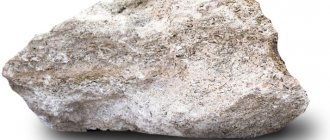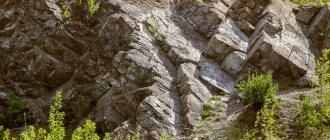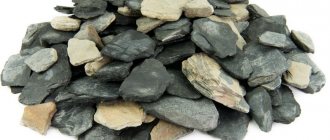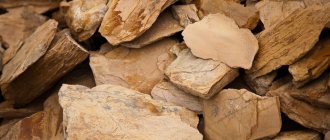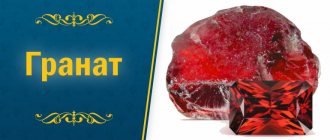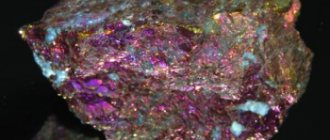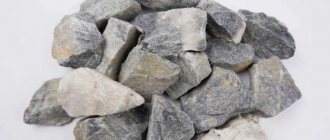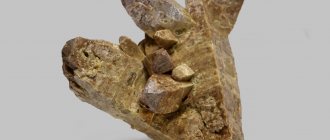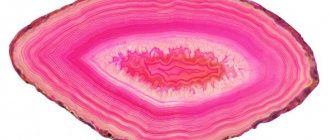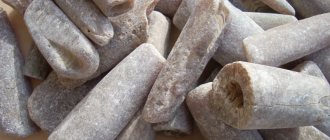Granite is a stone of natural origin. It is mined in many places on our planet and there is a possibility that it is not found on other planets of the solar system. Therefore, granite is called “the calling card of the Earth” in different sources. This is one of the most durable breeds in the world. Granite contains most of the known minerals: feldspar, quartz, as well as mica formations of various origins.
Is granite a mineral or a rock? This question is often asked by people who are just beginning to be interested in geology and mineralogy. At its core, it is a rock. As already mentioned, it includes different minerals, and its composition is heterogeneous, in contrast to minerals (for example, quartz, amethyst, chrysolite), which are uniform in both structure and color.
The granite rock is ubiquitous in our lives: in the form of railway embankments, tombstones, wall cladding, street elements of decorated decorations. Granite products have long seemed to people the most common and familiar to the eye. Often we just pass by without focusing on how different this amazing stone can be. Those who wish can get to know it better: after all, few people think about what granite is made of and what the history of its origin is.
History and origin
One lyricist in his poems associated granite with the words “edge” and “boundaries”, but the name of the stone arose from the Latin granum - “grain” . The name of the mineral was given by the Italian naturalist Caesalpinus. But the first information about the rock itself was recorded in documents from the times of Ancient Egypt and Rome. Then people used the material in the construction of fundamental structures.
Granite is often associated with strength and reliability. It makes up most of the earth's crust. There are even entire mountains made from this rock, for example, Mont Blanc. The stone is called the “calling card of the Earth” because it is not found on other planets.
Scientists give two versions of the origin of granite. Some experts believe that natural stone arose from molten magma, which slowly cooled in the earth's crust. Over time, it formed into a fossilized structure, and over many years, granite grains of various sizes crystallized in it.
Other scientists are inclined to believe that sedimentary rocks with sand and types of clay gradually shifted due to tectonic processes deep in the earth's crust. High temperatures and pressure caused the substances to melt. This process was called granitization.
Most of the world's granites are formed in collision zones. When two continental plates collide with each other, the layer of crust on the continent increases. Due to thickening, layered deposits of molten rock appear at a depth of 10−20 km. This phenomenon is called granitic magmatism.
Classification of granitoids by grain structure
The size and structure of grains differ from one another to different types of stone.
Based on this, granite comes in the following types:
- if the grain size does not exceed 2 mm - fine-grained ;
- grain size up to 5 mm - medium-grained ;
- coarse-grained appearance - more than 5 mm.
A fine-grained stone will have the highest level of resistance to mechanical damage. It is characterized by more uniform abrasion over time, resistance to winds and high temperatures. The fine-grained fraction is always the most expensive. It practically does not absorb water and is highly resistant to fire.
When building houses, coarse-grained granite is often used. It is cheaper, so after fires you can often see granite stairs that have cracked and are no longer usable.
Mining locations
Granite is common on all continents of our planet. In the USA, the rock is found along the Atlantic coast, in the northern part of the country, the central part of the Ozark Plateau, and the Black Hills. The mineral is mainly mined in Vermont, Wisconsin, Georgia and South Dakota. In Europe, large volumes of the breed can be found in Germany, Italy, Spain, Portugal and the UK.
The stone is also common in Russia. Large granite deposits are located in the Urals, the Caucasus, the Far East, as well as in Eastern Siberia and the Karelo-Kola region. There are more than 50 deposits where piece stone is mined. Granite crushed stone and rubble can be found in regions such as Prionezhye, Ladoga, Karelian Isthmus, Primorye, Eastern Transbaikalia, Khabarovsk Territory. The material is also available in the Arkhangelsk, Voronezh, Sverdlovsk and Chelyabinsk regions. The mineral with a high degree of decorative value is found in the north-west of the country.
At least 200 granite deposits are known in the post-Soviet space. The largest mineral deposits are found in Ukraine (Zaporozhye and Poltava regions) and Belarus (Brest region).
This is interesting
Interesting Facts:
- Archaeologists have found granite paving stones dating back hundreds of years. Granite pavements are in excellent condition, despite their age.
- The first information about rock processing was obtained from documents of ancient Egyptian architects. The top of the Cheops pyramid was lined with it.
- The third peak of the Himalayas, Kanchenjunga, 8586 m high, is made of granite. Other similar mountains are Mont Blanc in the Alps and part of the Cordillera mountain range.
- Some varieties have increased background radiation. However, the radiation values are too low to cause harm to humans.
- St. Isaac's Cathedral, Rostral columns on the Spit of Vasilievsky Island, Alexander Column on Palace Square in St. Petersburg are made of granite mined in deposits near Vyborg and in Finland.
Granite is a valuable rock that is widely used in construction. There is an opinion that this is an expensive stone, but its price fully pays for the durability of the material.
Sources
- https://zolotoe-runo-sl.ru/podelochnye-kamni/granit-kamen-opisanie.html
- https://pro-kamni.com/kamni/granit.html
- https://MoyKamen.com/vidy/podelochnye/kamen-granit.html
- https://velestone.ru/mineraly/opisanie-kamnya-granit-i-ego-osobennosti/
- https://vsekamni.net/2017/05/vizitnaya-kartochka-planetyi-granit
- https://prime-granit.ru/vidy-granita/
- https://nataly-moda.ru/podelochnye-kamni/svedeniya-o-granite.html
- https://lutch.ru/podelochnye-kamni/granit
Rock composition
The mineral belongs to the class of igneous rocks. It is presented in the form of crystals with a granular structure. The diagram reflects the three main substances that make up granite:
- feldspar - 60−65%;
- quartz - 25−35%;
- mica (biotite) - 5−10%.
The color of the stone depends on the volume of spar. More often you can find pink, red, gray and black minerals. Rare samples have blue or green shades. The amount of quartz affects the translucency of the grain. The more biotite a mineral contains, the more shimmer it shows when the viewing angle changes. Granite consists not only of aluminum, iron, silicon, potassium, calcium, manganese, hydrogen, oxygen and sodium. The chemical formula of different stones may include such minor elements as tungsten, lithium, titanium, chromium, etc.
Where are granite deposits located?
The main place where granite occurs is the batholith mountain ranges, the length of which is about 4 km and the area of several hectares. Sometimes during mining it is clear that several layers of stone have been formed: granite and its sedimentary rock. The stone itself appears in the form of wide layers, alternating with representatives of sedimentary and metamorphic species.
Like other minerals, which are not very rare, granite has become widespread almost everywhere: it can be found on any continent . Due to the fact that over millions of years, ancient rocks gradually displaced younger formations to the top, it came to the surface and became available for mining. Read more about where granite is mined →
Physical properties
One of the most important properties of granite is its strength. The smaller the grain size in the stone, the higher this indicator. This mineral is twice as strong as marble.
The stone is divided into three groups:
- Fine-grained. The grain size is less than 2 mm. Such minerals are characterized by a high degree of strength, resistance to destruction and water resistance. They are considered the most expensive and in demand due to their high quality.
- Medium grain. The grain size varies between 2−5 mm. The characteristics of this type are slightly worse than the previous one, but it is also often used in construction.
- Coarse-grained. Grains exceeding 5 mm make the material less fire resistant. At temperatures above 600 °C the stone is damaged and increases in volume.
The density of the rock is 2600 kg/m3, Mohs hardness is 5-7. Melting point - 1215−1260°C; in the presence of water and pressure it can drop to 650 °C. The average specific gravity of stone is 2700−3000 kg/m2. Granite is characterized by low water absorption and low abrasion coefficient. The stone is quite easy to process and polish , after which it retains its mirror surface for a long period. The mineral can also be carved. It can be given any shape.
The stone retains its characteristics even in the harshest environmental conditions. Granite is considered an environmentally friendly and ergonomic material. Any variety of this rock is safe for people and animals. Rock does not emit radiation. There are no restrictions on the use of granite in construction work.
Some types of stone can be given a decorative texture only after heat treatment. This is usually necessary for materials of light gray shades, which after finishing work become almost sugar-white.
How to distinguish natural granite from artificial
There are several signs that will help distinguish a real stone from a fake:
- Temperature. The original is cold. It takes a long time to gain temperature if you hold it in your hands. The fakes get warm quickly.
- Resistant to damage. Artificial analogues are easily scratched, unlike a natural sample.
- Drawing. Real stone has unique patterns that are not repeated. Imitation may have repetitions of some elements.
- Shine. The original is always matte, but a fake can be too shiny.
- Price. The suspiciously low price of granite products should alert you.
Color and pattern
The most popular is red or bright pink Leznikovsky granite. There are other varieties of stone that are named after their deposits, for example, the Korninsky, Sofievsky or Zhezhelevsky gray mineral.
Amazonite granite is considered to be a beautiful granite with a green or turquoise hue. Their color is due to the green feldspar contained in the rock. No less attractive are samples of amethyst color with a lilac-pink tint. The rarest type of stone is specimens with blue quartz. In some places you can find black granite. Minerals are also found in white color. Such samples look like marble. The stone can be not only snow-white, but also shades such as light green, pearlescent or pale yellow.
The pattern of granite depends on the accumulations of dark-colored inclusions. Minerals commonly found in nature have a spotted or speckled pattern. Some samples have striped-wavy patterns. Occasionally you can find granite with a pattern resembling circles or chains. A dotted pattern is formed on the rock if it contains inclusions of flat-shaped spar crystals.
Basic characteristics
Even the name of this stone indicates its structure - the word granum is translated as grain. Granite has a corresponding coarse crystalline structure. It is not for nothing that the stone is recognized as one of the most durable and resistant to any temperature. According to these characteristics, even marble is inferior to it.
Granite is often compared to concrete. And for good reason, since stone is much stronger than concrete. Studies have shown that granite can withstand much more pressure (6 times). Another distinguishing feature is the density of granite. Stone even weighs more than concrete.
Other varieties
There are many classifications of stone according to different criteria. Based on the nature and content of dark-colored inclusions, granite is divided into the following types:
- Alaska. Does not contain dark inclusions.
- Biotite. The volume of biotite in the mineral varies between 6−8%.
- Leucogranite. Low level of dark-colored particles.
- Double mica. Such minerals include biotite and muscovite.
- Lithium fluoride. The stone contains lithium micas.
- Pyroxene. The composition contains augite, quartz and orthoclase.
- Alkaline. Characterized by the presence of alkaline components.
Granite is also classified according to its grain structure. Porphyry-like stone is distinguished by brightly defined long inserts that protrude from the main mass of the rock. Pegmatoid granite is characterized by a symmetrical and uniform grain pattern. Finnish rapakivi stone is characterized by rounded inserts with a gray or greenish frame. The gneiss-like mineral has a fine-grained structure.
Areas of application
Durable rock has been used in architecture since ancient times. Not all people know that the Egyptian pyramids were built using granite. Many structures were built in Ancient Rome and India. The stone, which is characterized by durability, can withstand any climatic conditions. He is not afraid of either wind or rain.
Today, granite is used to make not only various buildings, but also stairs, steps, curbs, and street tiles. The mineral is used in the construction of monuments, sculptures, vases, columns, bridges, benches, artificial reservoirs and other architectural objects. Natural material is often used to create countertops.
The excellent performance characteristics of granite allow it to be used not only for external, but also for internal work. It is used for cladding walls and floors in a house or apartment. Any product made from a reliable building material is easy to use. No complex maintenance is required to maintain the finish in its original form.
When people decide to choose granite for finishing their home, they often doubt the choice of the appropriate stone option. Among the large variety of species, it is difficult to determine which material is considered the best. The choice of mineral depends on the purpose of its use. It should be mentioned that liquid granite, which can replace cement, is a new prospect in construction.
The stone looks harmonious in combination with marble. Items with a combination of these materials look attractive and majestic. And sometimes white granite can replace marble, which it is very similar to after proper processing. Since stone is more durable than marble, during use it does not lose its original shade, structure, or texture. Granite has only one drawback: it has the greatest weight among building materials, which must be taken into account when constructing bridges, monolithic houses and other large structures.
Stone processing
The stone is very durable. You can split granite stone with a hammer, cleaver, or sledgehammer. You can break the stone into two parts, split it into several large parts, knock off some parts (shards) or trim it, giving it the desired shape, creating edges - smooth surfaces (faceted granite).
During processing, diamond drills are used for cutting and grinding. It is easy to give the source the desired shape using a tesque. Sometimes heat treatment is required. Heat-treated granite has a rough surface. Bush hammered granite also has such a surface. The essence of the treatment is the shock-rotational effect of special sprockets made of hard alloys.
On the map, the symbol for granite is crosses (pluses) in a frame.
Also watch the program about processing:
